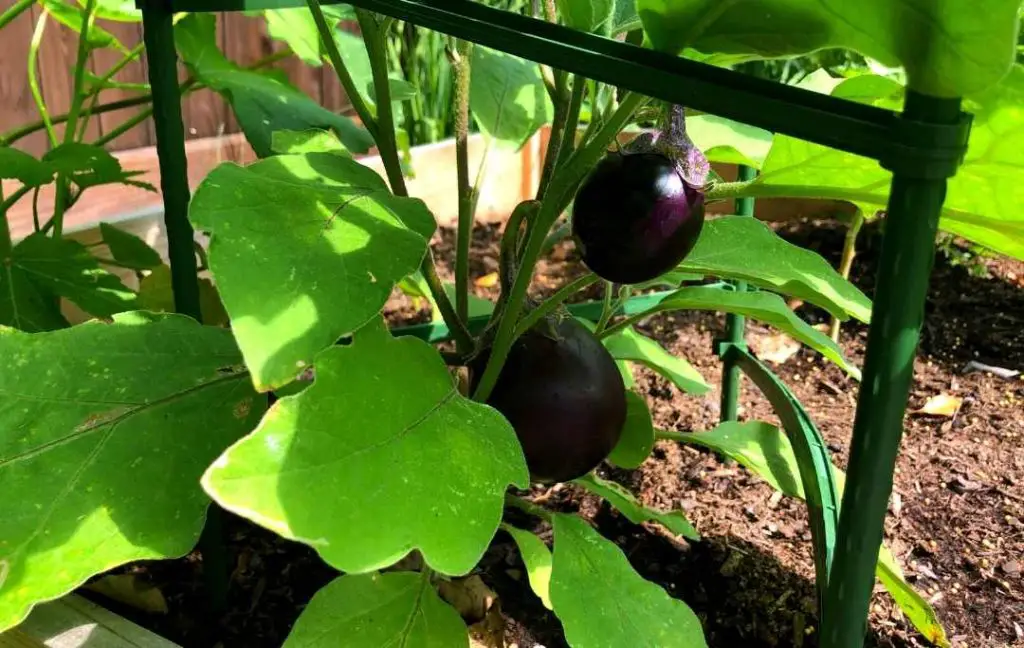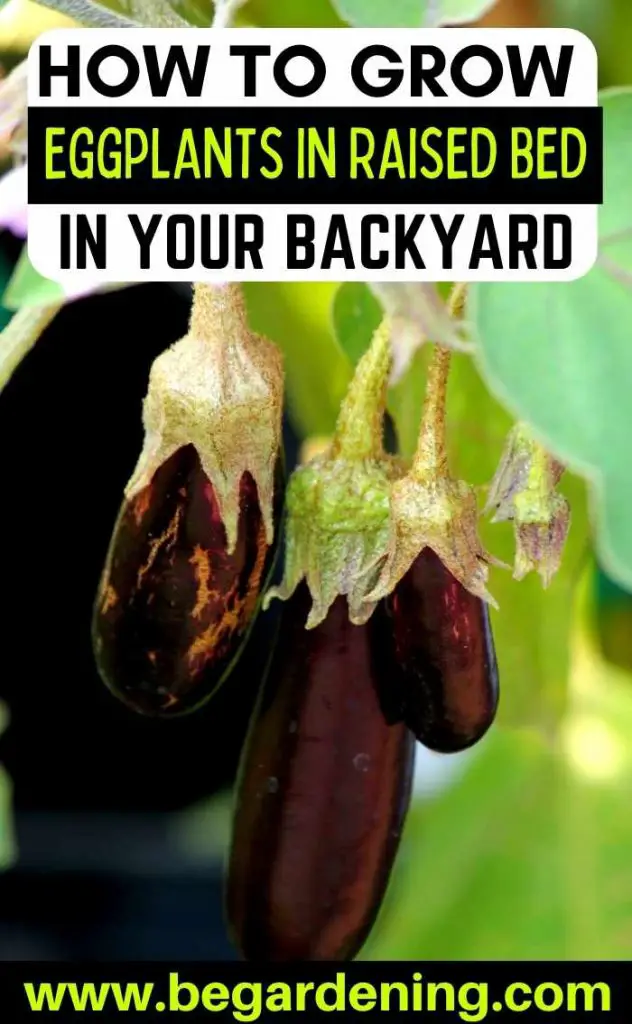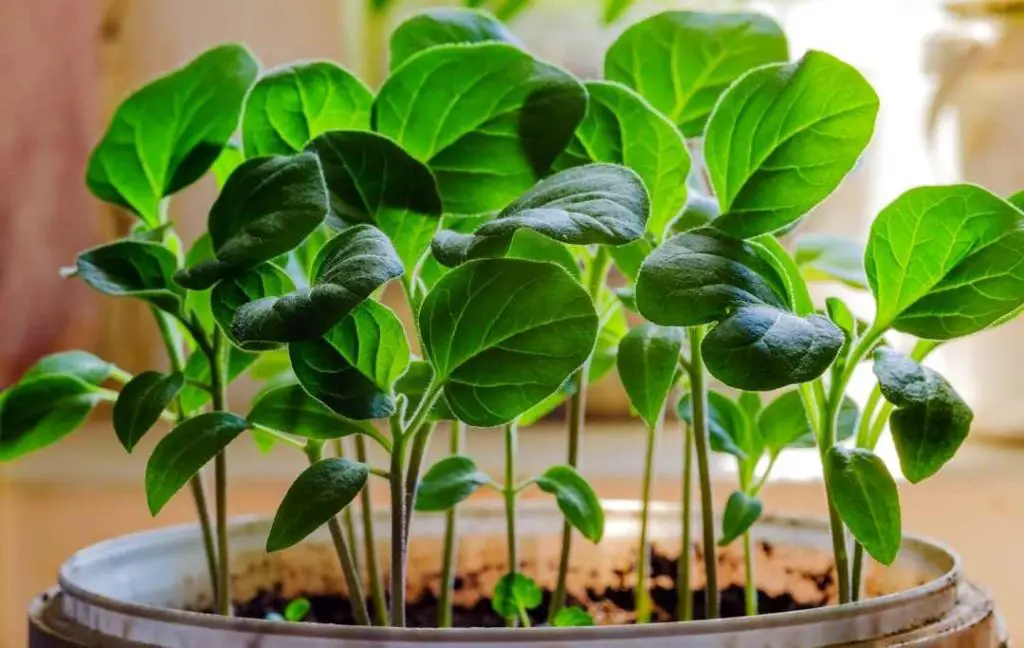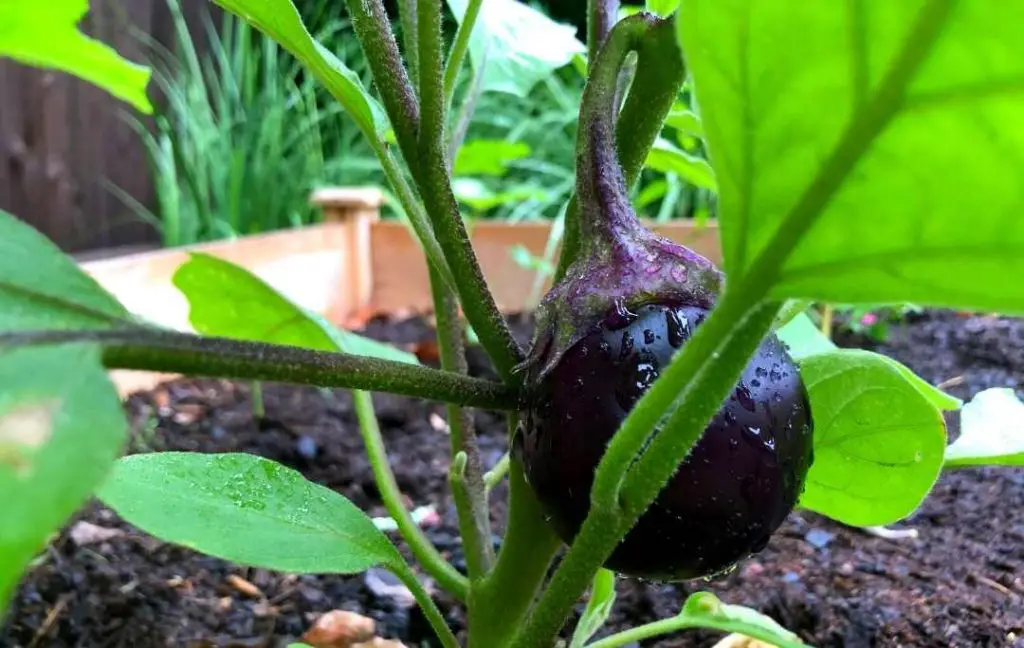It is a perennial and warm weather-loving plant. The classic eggplant has a deep purple color and is pear-shaped. It is best to grow eggplants in a raised bed because the soil in the raised bed warms up quickly in the spring so you can start your growing season earlier.
Why Use Raised Garden Bed?

There are several benefits of raised beds. The most important advantage of a raised bed is that it provides control over the health of the soil. You can maintain the fertility of the soil which is not possible if you grow plants in the ground.
If the soil of your garden is not good such as then it is suggested that you should use raised beds for growing your vegetables, especially eggplants.
When you grow eggplants in a raised bed then your plants will be at eye level for better observation. It is very easy for you to keep an eye on your plants. In case of invasion of pests, you can easily detect the presence and get rid of the problem at the start.
If you have any physical issues then you can grow eggplants in the raised beds. Bending and kneeling are part of gardening. If you grow plants in the raised bed then you can avoid bending.
Raised Bed Size Considerations
Raised beds which you buy from the gardening store can be expensive. If you don’t want to spend more money then you can also build raised beds according to your desired size.
Building raised beds can be done without any experience. The size of the raised bed is very important. You should build or buy a raised bed according to the size of your garden.
HEIGHT
The best height of the raised bed is 12 to 18 inches. If you want to build a low raised bed then 6 inches can also work and be productive.
WIDTH
3 to 4 feet is enough and works perfectly. Keep in your mind, don’t build a raised bed more than 4 feet. The reason is that more wide raised beds become a trouble for you.
You can’t reach the middle plants and maintenance of the center of the plants becomes very difficult. If you step into the bed then the soil will become compact and affect the drainage. This will disturb the health of your eggplant plants.
LENGTH
The raised bed of 4×4 is perfect. This is a square-shaped raised bed and you can easily maintain your plants. But you can increase or decrease the length according to your needs. The length of the raised bed depends on your space and budget.
SHAPE
The shape of the raised bed can be rectangular, circular, or oval. The shape of the raised bed depends upon the area of the garden you have. If you have a large garden then you can create or build a long raised bed but for a small garden and limited area, you can choose the size and shape of the raised bed.

Prepare The Garden Bed Area
After choosing the site for your raised bed the next step is preparing that area. Make the surface equal. If you find any stones and rocks then remove them.
If you find the grass in that place then discard it. If that area is weed infested then solarize the area. This process will take four to eight weeks but will help to kill the weeds.
Which Materials Are Safe For Raised Beds?
You can use different materials to build a raised bed.
- You can use untreated wood. Cedar, redwood, cypress, walnut, oak, and black locust are the best types of untreated wood. They are known for their rot-resistant qualities and last for many years.
- You can also use galvanized metal but during the galvanization process, the metal is dipped in molten zinc for zinc-based coating. Too much zinc is not good for plants.
- Cinder blocks or concrete blocks are also used for building raised beds.
- You can also use composite wood for building raised beds. This is made from recycled materials.
Fill The Raised Bed With High-Quality Soil
After building the raised bed, the next step is filling the raised bed with a high-quality potting mix. When you grow plants in a raised bed then you can maintain the fertility of the soil which is not in the ground beds.
Make sure your soil should be well-drained and fairly rich in organic matter; the pH of the soil should be between 5.8 and 6.5. if you want to keep the soil warm then you should cover the soil with black plastic mulch before setting out transplants.
Eggplants need a moderate amount of fertilizer. You should apply one inch of well-rotted manure or general fertilizer throughout the raised bed. This should be done about a week before planting. 1¼ pounds of 5-10-10 of general fertilizer is enough when the row spacing is about 4 feet.
When To Plant Eggplant?

You can start seeds indoors before the last spring frost date. The suitable temperature for the germination of seeds is 70 to 90 degrees Fahrenheit. Instead of preparing your seedlings, you can also buy six to eight weeks old nursery transplants.
When you buy a transplant from the nursery then you should select high-quality specimens and avoid buying tall and spindly plants. You should also not purchase young plants that have blooms.
Before transplanting you should wait until the last threat of frost passes. This is the best time for transplanting eggplant in your raised bed.
How To Plant Eggplant?
- Staking is very important before transplanting eggplant in the raised bed. Eggplants need proper support when they start climbing. If you install the support after the plant grows then it will disturb the roots which are not good for your plant.
- Eggplant is a warm weather-loving plant and if you are living in a cold area then you should cover the rows of eggplants to keep them warm and sheltered. During the day you should open the row covers and allow the bees to pollinate. At night again cover the eggplants.
- Transplant 3 to 4 inches tall seedlings in the raised bed. In each row, there should be a distance of 2 to 2 ½ feet. The number of rows depends upon the size of the raised bed in which you are growing eggplants.
- After transplanting the seedlings they need an appropriate amount of water. You should add a layer of mulch; it will help to retain the moisture and reduce the number of weeds. Weeds are unwanted plants and they start a competition of nutrients with the eggplants. Mulch will help to surpass them.
How To Grow Eggplant?

- You should use a cage or stake to provide proper support to the plants of eggplant. When they start producing fruit then the branches of the plant are fully loaded and they will fall if not get proper support.
- In case, the plant starts producing bigger fruits then you should restrict 5 to 6 fruits per plant.
- For bush varieties, you should pinch out the terminal growing points.
- Moist soil is recommended for growing eggplant so you should water regularly to keep the soil moist. You should avoid overwatering because sogginess will encourage diseases. Make sure your eggplant gets consistent water.
- When the plant is developing the fruit then you should maintain the moisture by mulching. Mulching is very important to provide uniform moisture and reduce weeds.
- A balanced amount of fertilizer should be applied twice during the growing season. Avoid using too much nitrogen because it will encourage vegetative growth, not fruit. In case if you are using plastic mol then you should apply the fertilizer throat drip irrigation system.
Pests, Diseases, And Common Problems
The common pests and diseases of eggplant are as follows.
FLEA BEETLES
This is the most common pest which can affect the eggplant but if your plant is healthy enough then it can withstand it. The young seedlings are seriously affected by flea beetles to protect your plants. You should cover them and let them grow enough to tolerate the leaf damage. If you want to get rid of beetles then you should remove the garden debris in the fall.
POWDERY MILDEW
When you see white and powdery spots on the leaves, it means your plant is affected by powdery mildew. This will become the reason for turning the leaves yellow and finally, the leaves will die.
Prevention is very important to control it. You should plant disease-resistant varieties. The location of your bed should get full sun exposure and good hair circulation. Make sure you pour water at the soil level, not on the leaves.
TOMATO HORNWORMS
Tomato hormones are also a problem for your eggplant.
- The plant is producing flowers but without developing into fruit it fell off. It means the temperature is too cold to develop the fruit.
- If your plant is not producing a large fruit it’s probably too cold. Eggplant is a warm-weather crop. It likes hot climates. The daytime temperature should be between 80 to 90 degrees Fahrenheit and night temperature should not below 60 degrees to 65 degrees Fahrenheit
- Inconsistent water supply will result in strangely shaped eggplants.
Harvest

- After 65 to 80 Days of transplanting, your eggplant is ready for harvesting. The maturity time depends on the variety which you are growing in your raised bed. If you start from the seeds then it will take a hundred to 120 days to mature. July to September are the harvesting month of eggplants but it depends on your climate and the variety.
- Young eggplants taste best so you should not wait too long to harvest. The plant will consume its energy to produce new fruit. You should check your eggplant every 2 to 3 days.
- The easy way to check the fruits is ripe when the skin fails to rebound to fingernail pressure. If your fruit is overripe or underripe then it will taste bitter. At harvesting time the skin of the fruit looks glossy and has a uniform color. When you cut the eggplant you will see that there are soft seeds. If the skin of the fruit is faded and the seeds inside are dark then it means the fruit will give you a bitter taste.
- Harvesting is an art so you should not pull the fruit but use a sharp knife to cut off the fruit from the branch. Calyx or green cap can be prickly so it is recommended that you should use gloves.
How To Store Eggplant?
- You can store eggplant in the refrigerator for one week. The storage temperature should be 45 to 50 degrees Fahrenheit. The humidity level should be 90%.
- You should avoid washing or cutting in advance because it will damage the skin.
- If you want to protect your plant from discoloring after cutting then you can use salt, vinegar, and lemon juice for marination.
